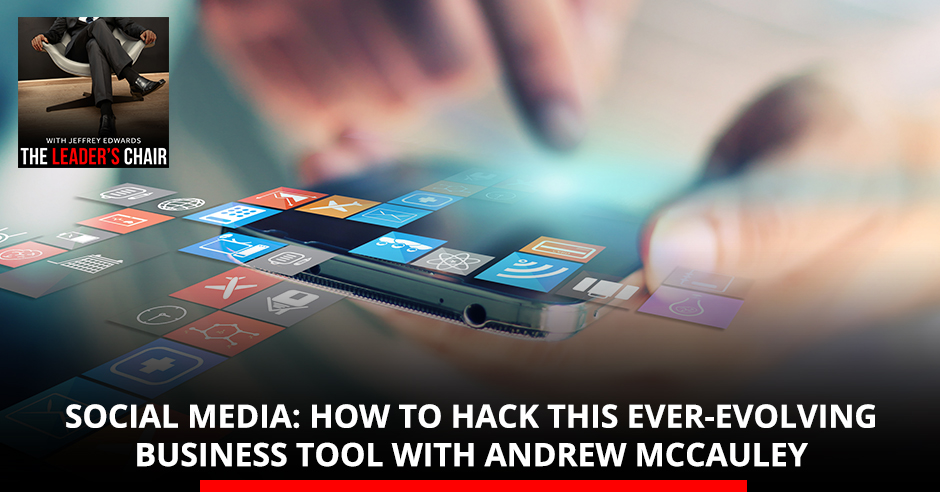
Young or old, everyone is involved with social media. Even your pet dog can get a large following!
Things are ever-changing online, and it’s essential to pay attention to trends. In this episode, social media consultant Andrew McCauley shares his proven insights on how to leverage social media to boost your presence in your industry.
About Andrew McCauley

Andrew McCauley is an author, speaker, social media consultant, and the founder of Social Media Bloke. Named one of the top 100 Most Influential Twitter Users and an Amazon Best-Selling Author, Andrew consults all types of businesses on their online strategy.
Speaking at 300+ live events, Andrew’s customized online strategies have seen 300-500% growth to his clients’ websites, and his podcast has been downloaded in over 120 countries.
Check out this episode if you want to learn:
- What it takes to grow your social media following (hint: it takes consistency!)
- Why you might have to pay for social media ads
- Which social media trends are new — and which ones will always be there
🎧 Listen to the podcast here:
Social Media: How To Hack This Ever-Evolving Business Tool With Andrew McCauley
Let’s get behind your company, ‘Social Media Bloke’. Where does that come from?
The word ‘bloke’ is an Australian term for a guy. I’ve been living in the US for many years, (so) it’s a bit of a nod to my Australian roots.
I got involved with Facebook in 2006, and it was way back when (social media) was early. This is why (I’m the) original Social Media Bloke, because I’ve been doing it for a long time.

Social Media Hack: One of the things that stayed consistent more than anything is that at the end of the day, people are using social media platforms.
What got you into the social media industry?
'People are getting very savvy to what they want to see, and quick to get on the closed down button if you’re running ads.' Share on XIn 2006, I started my own consulting business. One of my first clients came to me and said, ‘There are some people using this thing called Facebook for Business. Can you help us do that? It looks cool.’ I’m like, ‘Not a problem.’
I went home, and I Googled ‘what is Facebook?’, because I’d never heard of it before. That began my love affair of finding out how people were marketing their business on this new platform called Facebook. As far as I (could) see, all people were doing was sending photos to each other, talking about their dinner, and playing some game called FarmVille. I (was) like, ‘This is weird. How are people making money doing this? I need to learn more.’
I’ve been a student of marketing all my life, (so) I started looking at how people were getting their message out to people. (Using Facebook), I started getting some early results, and it led from there.
Twitter came along, LinkedIn, YouTube. (Lots of) social platforms have (come) and gone since then, too. It all became a new way of dealing with your potential customers, (without) networking and meetings. You could get your message out across the world easily and rapidly.
In the early 2000s, we had Myspace. Now, there’s over 100 different platforms out there! What are the trends that you’re seeing?
It’s evolving rapidly. Every day, there’s a new algorithm update, but ultimately, these updates (are) more for the user experience than anything else.
At the end of the day, these are platforms that people are using. If we’re doing business on social, it shouldn’t be any different than (how) we did business many years ago. You are finding where your target market is, (because) some of these platforms cater to different genres or tastes.
You’ve got things like Facebook and Instagram (with) lots of videos (and) pictures. You’ve got YouTube, which has all video. Clubhouse is all the audio, Pinterest (is) all images. You’ve got things like Snapchat, which has things that disappear as soon as you watch them.
There are all different ways to get people’s attention. The expansion of it is that we’re not (using) one platform to cater to everybody. We see Clubhouse and TikTok coming out, and they’re catering to people that like that delivery.
Facebook, for a long time, was the main (platform) that people would go to. Now, we’re starting to see people (be) a bit more discerning, (saying) ‘I don’t have time for all of (the platforms) anymore.’
People are (also) getting savvier to what they want to see. You’ve got to be giving them valuable, entertaining, engaging content. Stock ads that we used to see on Facebook don’t cut it anymore. You have to be creative. Even (with) ads on YouTube, you see stories being told inside that video. Users (can) click off (your ad) real quick, (and) you don’t want that to be happening.

Social Media Hack: If you’re a business owner trying to capture people’s attention, you’ve got to do it in the first millisecond.
It’s an area that I fight with it every day. On the one hand, it’s great, and literally opens you up to the world. At the same time, there’s so much you have to do to build your presence. What do you see leaders struggling with the most, when it comes to social media?
The fact that they feel like they have to be on all the platforms. (Also), they don’t understand where the majority of their target market is.
There (may) be people that they could possibly get as clients from all the platforms, but start looking at the 80/20 rule. (It’s the) Pareto principle, (saying) most of your clients will come from one or two platforms. That’s where you want to start spending your time. You might have to sacrifice some people from TikTok or Clubhouse or whatever, because there are not a lot of people there.
(I say to clients), ‘Let’s focus on one (platform, and) get the systems (in place) to respond to people in a timely manner. If we’ve got time, let’s look at a different platform.’
Social media can be very stressful.
There are also a lot of mental health issues stemming from social media, especially FOMO (Fear Of Missing Out). Look at your Facebook feed, and you’ll see the same people posting glorious pictures of food, travel, (saying) ‘look what I’ve done.’
Some people get that feeling, ‘I wish I was there.’ When the reality is that they’re probably only picking their best pieces to show — the rest of it is boring and bland. Especially kids these days are looking at this, and they’re getting upset or depressed because their life is not like these glorious things they see on Instagram, Facebook, TikTok or Snapchat.
It can be a bit of a mental drain for people. I started not (looking) at certain people on Facebook anymore. I’m sick of the same old crap, because it’s not their real life.
There are generational gaps, too. You and I, we’re not spending all of our time on social media. Think of the teens and 20-somethings who have grown up with it. What’s been your experience in seeing that population’s relationship with social media?
'Social media tends to sensationalize a lot of people’s lives.' Share on XI (had) my niece here over Christmas. She was on her phone almost 24/7, flicking between different applications. Their attention span is short, because they see a 15-second TikTok video, (and then) they bang onto the next thing.
As a marketer, you’ve got to be able to capture people’s attention spans. When we had TV, they used to say that our attention span was about the distance between the two ads on a TV show. A half-hour TV show, you get three sets of ads, and it would be eight minutes between the ads or whatever it was.
Now, our attention span is down to that of a goldfish, because of (the) flicking between (apps). If you’re a business owner trying to capture people’s attention, (you’ve got to do it) in the first millisecond. It’s not a second anymore, but millisecond.
At the same time, if I want to attract a following, content is king — but so is consistency.
That word, consistency, is number one. It is probably the number one thing that has seen me get results. If you’re doing a podcast, be consistent about the dates or the times that you post it out. If you’re posting on social media, be consistent.
I’ve tested this with a whole bunch of things. Every time I’m consistent, I see the results go through the roof, and every time I’m not consistent, it doesn’t work.
People underestimate (consistency). If you can put in a scheduling service or pay someone to be a consistent (social media manager), you start seeing better results.

Social Media Hack: If you’re going to do something, do it consistently, and you’ll find you get good results.
What have you found to be some of the best strategies for being consistent?
I have an app on my phone that reminds me to do stuff every day, (but) I snooze the alarm and it’s gone — I forget about it. If you’re going to use those tools (like social media scheduling), you need to make sure that you are doing what it tells you to do.
It’s the accountability part that a lot of people will lack. ‘I don’t need to do that, I’ll mark it as done.’ This is why I even (suggest you) pay somebody; you can get a virtual assistant, and their job is to remind you ‘Get to the blog post. Do your social.’ That’s their job. You’re paying for it, and that will keep you on task.
For those who are still trying to build their online platform, what are some keys pieces to consider when creating content?
You pick the right platform first, where your potential market is going to hang out. If it’s LinkedIn, stick to LinkedIn — get good at it, make sure your bio (and) all (the) bits and pieces are filled up, (so) people know who you are.
Develop your content around (the) platform, because each platform is a little different. Your TikTok platform is all about short videos, (while) your LinkedIn platform might be a little bit more corporate-y. The messaging has to be a little bit different. Learn what your customers like, and then start to deliver that content.
The important part is measuring what you’re doing. You’ve got to look at numbers. Numbers drive what you should be doing all the time. If you’re putting out blog post after blog post for weeks on end, and nobody’s coming, then there’s a message there. Something is wrong. It could be the message itself, the title, the audience you’re going after. Look at your posts. If you’re putting out videos on Instagram or TikTok and nobody is listening or watching them, there’s something wrong.
It can be very hard to get those numbers up.
These days, with social media, it’s a pay-to-play platform. You are not going to get the organic reach that we were getting many years ago. (There were days when) we used to be able to (post) something, and all our followers would see it, because they were (our) followers. On Facebook, especially, it doesn’t happen anymore. They got rid of that.
Have a look at Converse shoes’ Facebook page. They’ve got 46 million followers. That’s twice as many people (as) Australia! (But) when they put a post out, they are lucky to get 100 or 200 people like it. They stopped posting because it was a waste of time — 200 people out of 46 million were not worth their time.
You’ve got to (ask), ‘How do I get my message out? Maybe I need to pay-to-play, and get my message in front of the right people.’ The good thing about that these days is that when you’re paying for ads on social media — it doesn’t matter what platform it is — you have the ability to target your right market.
You’re not putting a billboard out on the freeway where random people may or may not see your sign, or a TV ad where the wrong people are watching the TV show. You’re putting out something that’s super targeted. The value that we’re getting for advertising dollars is a lot greater than it ever was. I encourage you to use that stuff, too.
Attention spans are disappearing real quick. Share on XIt is truly a whole new world out there.
It’s a minefield. I’d hate to be a small business owner, trying to be good at what I do in my own business, (on top of working out how to leverage social media). It’s baffling for a lot of them, but they need to do it because this is where their audiences are these days.
You’re saying: don’t get caught in the overwhelm. Pick one platform, learn it, own it, and be consistent with what you put out there. After it’s working, then you can consider using other platforms.
Take it one step at a time. Grab a platform where your audience is going to hang out, get good at that, and stick with it. Once you’ve mastered that, (the platform will) change the algorithm. You have to get back into it again. Once you have mastered that, you can go on to the next platform.
Stick to one platform, get good at it, then you’ll find your life will probably become a lot easier, because you’re not stressing out about trying to be everywhere all the time.
📌 Important Links:
- Social Media Bloke
- Twitter – Andrew McCauley
- Facebook – Andrew McCauley
- LinkedIn – Andrew McCauley
Love the show? Subscribe, rate, review, and share!
Join The Leader’s Chair Community today on Facebook and Twitter.





